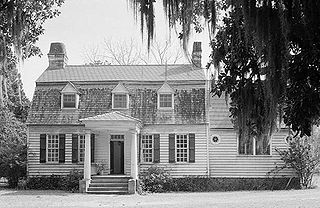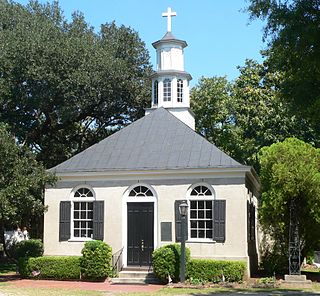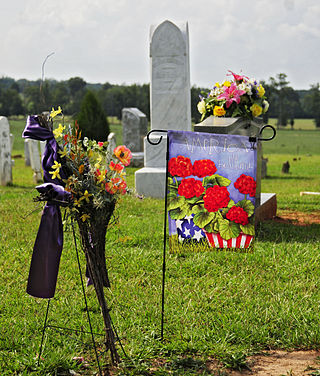
Mount Pleasant is a large suburban town in Charleston County, South Carolina, United States. In the Low Country, it is the fourth largest municipality and largest town in South Carolina, and for several years was one of the state's fastest-growing areas, doubling in population between 1990 and 2000. The population was 90,801 at the 2020 census.

Mount Pleasant Cemetery is a historic rural cemetery in the North Ward of Newark in Essex County, New Jersey, United States. It is located on the west bank of the Passaic River in Newark's Broadway neighborhood, opposite Kearny. It occupies approximately 40 acres and was designed by Horace Baldwin. The cemetery is listed on both the New Jersey Register and the National Register of Historic Places.

The Coming Street Cemetery is located at 189 Coming Street, in Charleston, South Carolina. This Jewish cemetery, one of the oldest in the United States was founded in 1762 by Sephardi Jews and is the oldest Jewish burial ground in the South. Burials in the Coming Street Cemetery are now restricted to the few vacancies in the adjacent family plots. The cemetery was listed on the National Register of Historic Places in 1996.

This is a list of the National Register of Historic Places listings in Charleston County, South Carolina.

The Oakland Plantation House which is also known as Youghall or Youghal Plantation House, was built about 1750 in Charleston County, South Carolina about 7 mi (11 km) east of Mount Pleasant. It is located about 1 mile (1.6 km) south of U.S. Route 17 on Stratton Place. It was named to the National Register of Historic Places on July 13, 1977.

Magnolia Cemetery is a historic rural cemetery in Charleston, South Carolina. The first board for the cemetery was assembled in 1849 with Edward C. Jones as the architect. It was dedicated in 1850; Charles Fraser delivered the dedication address. It was listed on the National Register of Historic Places as a Historic District in 1978.

Christ Episcopal Church is a church located in Mount Pleasant, South Carolina.

Edward Culliatt Jones was an American architect from Charleston, South Carolina. A number of his works are listed on the U.S. National Register of Historic Places, and two are further designated as U.S. National Historic Landmarks. His works include the following :

Remley Point Cemetery is a cemetery located in the Scanlonville community in Mt. Pleasant, South Carolina. It contains 41 marked graves ranging from 1867 to 1989, but residents claim there may be over 1,000 people, largely African American, buried there. It was added to the National Register of Historic Places in 2p02.
Cook's Old Field Cemetery, also known as Hamlin Cemetery, is a historic cemetery located near Mount Pleasant, Charleston County, South Carolina. It contains graves dating from 1805 to 1916; the majority date from the 1840s and 1850s. The oldest marker is for Arnold Wells who died in 1805. On July 16, 1863, Mary Moore Hamlin set aside one acre of land for the dedicated cemetery.

The Josephine Martin Glidden Memorial Chapel is a historic church at 2121 E. Twelfth Street in Sioux Falls, South Dakota. It was built in 1924 and was added to the National Register in 1987.
Hopkins Family Cemetery is a historic family cemetery located near Hopkins, Richland County, South Carolina. It was established about 1775, on the Back Swamp Plantation. A wall and stile were built about 1835–1837. It contains 69 marked graves of the Hopkins and related families.

Butler Family Cemetery is a historic family cemetery located near Saluda, Saluda County, South Carolina. It is located behind the Butler Methodist Church. It was established about 1802, and includes the graves of members of one of South Carolina's leading families. Notable burials include: William Butler (1759–1821), Pierce Mason Butler (1798–1847) and Andrew Pickens Butler (1796–1857).

Randolph Cemetery is a historic cemetery for African-Americans in Columbia, South Carolina. It was established in 1872 and expanded in 1899. It was named for Benjamin F. Randolph (1820–1868), who was reburied at the cemetery in 1871. Randolph was a militia leader protecting African Americans when he was assassinated. A memorial in his honor and for other African-American leaders killed was erected. Gravemarkers include both manufactured and vernacular homemade varieties. The cemetery holds eight Reconstruction Era state legislators. It was added to the National Register of Historic Places in 1995.

Spratt Cemetery is a historic family cemetery located near Fort Mill, York County, South Carolina. It contains graves of three generations of the Spratt family, and other early settlers of the Fort Mill area. The cemetery consists of 14 marked graves and approximately 9 graves with broken stones or partial markers. It includes the grave of Thomas "Kanawha" Spratt, one of the first settlers of the area, and located adjacent to the site his homestead along Nation Ford Road. The land was provided for the Spratt homestead by the General New River, leader of the Catawba tribe.

Richland Cemetery is a historic African-American cemetery located at Greenville, South Carolina. It was established in 1884 by the City of Greenville as the first municipal "colored" cemetery. It is the final resting place for many of Greenville's most notable African-American educators, health practitioners, and community leaders. The total number of graves is estimated at over 1,400 and gravemarker types and materials range from natural stones to elaborate Victorian monuments.
Fort Palmetto is a historic artillery battery located at Christ Church Parish, Hamlin Sound, Charleston County, South Carolina. It was built in late 1861, and was at the easternmost end of the Christ Church Parish line of defense. At the end of the war this battery mounted one nine-inch gun and two rifled thirty-two pounders. The earthen redoubt measures approximately 160 feet long and 80 feet wide. It has a 15 foot high parapet wall and a powder magazine about 25 feet in height.
King Cemetery (38CH1590) is a historic African American cemetery near Adams Run, Charleston County, South Carolina, containing at least 183 graves. Oral history documents the extensive use of the graveyard during slavery and continuing into the first half of the 20th century. Distinctive characteristics include the placement of grave goods, ranging from ceramics to bottles to household furniture, on the grave and the use of plant materials as markers.
The Lawton-Seabrook Cemetery is a small private cemetery at 7938 Steamboat Landing Road on Edisto Island, South Carolina. It is notable for its high-quality brick perimeter wall, and for its funerary markers, which are attributed to local master carver Thomas Walker and his family. There are only seven original gravestones, with additional otherwise unmarked potential graves marked by modern stones.


















